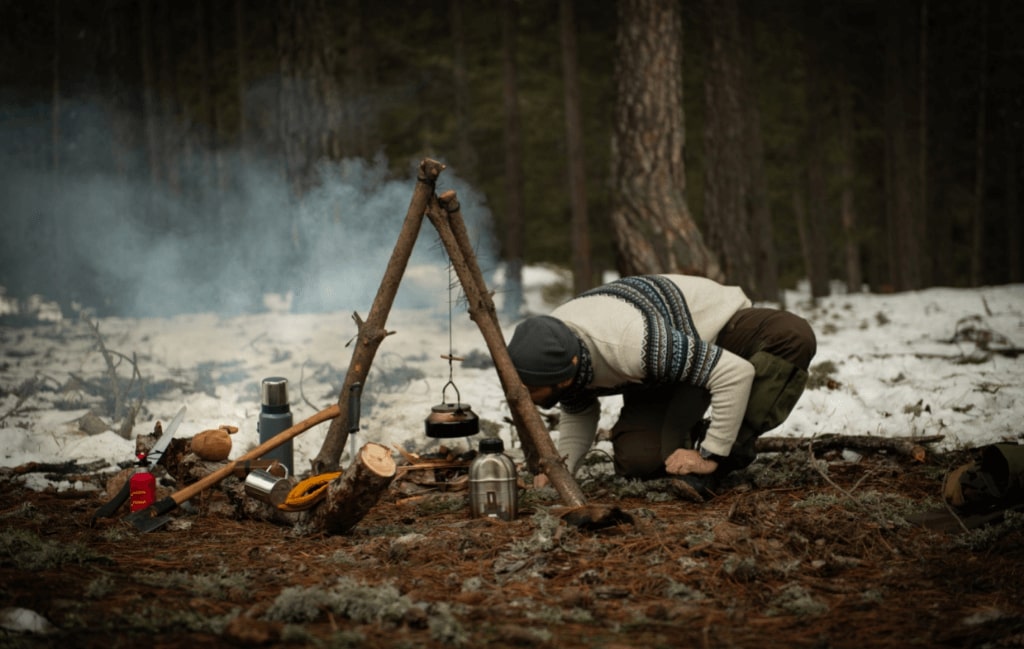Bushcraft carving projects can be a great way to learn new skills and have fun with your friends.
Bushcraft includes an array of survival skills, including tracking animals, building shelters, finding edible plants, making tools from natural materials like stone or wood, and even fire starting.
The first step in any bushcraft project is to plan and gather all the necessary resources before starting working on your project. What type of tool will you need? Where will you find the material for your project? Have you ever tried this skill before? These are all important questions to ask yourself when designing a bushcraft project.

What is bushcraft carving?
Bushcraft or fieldcraft is the ability to use natural resources to provide for basic needs, including shelter, food, water, and security. It involves making tools from natural materials available in the bush environment where one lives and using those tools to make other items.
Bushcraft skills include the ability to build a fire, find clean drinking water, navigate across land using various techniques such as map reading, use of a compass, building shelters for protection from weather and/or wildlife, and finding food.
Bushcraft is not just about collecting survival gear (food storage containers), stocking every item on your list (clothing), or building that huge backpack that weighs 50 pounds. You cannot rely on new equipment or supplies if you truly look into Survivalism – living off the grid when SHTF hits! I urge people to take the initiative in learning how to do things for themselves – it’s called taking responsibility for yourself / family/group members, etc.
Types of bushcraft carvings
Several types of carving can be done with bushcraft tools, including wood carving, stone carving, bone carving, and even metal carving.
These intricate skills take years to master, but once you figure it out (through YouTube tutorials & practice), you will be able to create works of art in the middle of the wilderness using nothing but a knife and your hands! For more background info, visit Backpack Guide USA.
Materials for bushcraft carvings
Obviously, you’re going to want to work with wood or stone as these are both fairly easy materials to obtain, especially if you live in a suburban area.
However, don’t get too comfortable working exclusively with natural resources from your own environment – this is a great way to practice. Still, eventually, you should branch out into exploring other locations (for new materials) so that you can learn more skills and collect different types of items for future Bushcraft projects!
Tools for bushcraft carving
I recommend using a camp saw, knife, or even a shovel if you’re working with stone – these are great tools to use when you don’t have access to power tools.
There is almost no substitute for the experience because only through trial and error will you be able to figure out what works best in your environment. For example, I was introduced (through YouTube) to flint knapping which is the skill of making sharp edges on stones by striking them with another harder rock.
Without this knowledge, it would’ve taken me years to master my skills, and instead, I was able to practice this very quickly where I live now! So make sure that you find some local bushcrafters / survivalists before trying to make some of these projects – some stones/knapping may be very difficult to master on your own!
Safety precautions when working with knives and sharp objects
Safety should be your #1 concern when working with any knife – remember always to keep the blade away from your body and use a good block with a cutting/carving area (not wood).
On the same note, it is important that you respect all of your tools since they can be deadly if not handled properly. Always cut away from yourself while using knives/blades and try to avoid moving around too much when sawing logs etc. This will eliminate many unnecessary risks so that you don’t get hurt!
Finally, I cannot say this loud enough – ALWAYS KEEP FIRE AWAY FROM KNIVES AND OTHER SHARP OBJECTS!! Never store these items anywhere near dry tinder or other flammable materials since one stray spark could cause a disaster!
Common mistakes to avoid while doing a project
The only common mistake that I can think of is not respecting tools/materials – if you’re not paying attention to what you’re doing, this could lead to serious injuries or even death (for example, dropping a knife on your own foot).
As previously mentioned, safety should be your #1 priority while working with sharp objects and this means being aware of everything around you at all times. The last thing you want to do is accidentally cut your fingers off while trying to produce some kind of bushcraft carving masterpiece!
Steps to make a bushcraft carving
The steps are simple, just follow these:
- First, find a good piece of wood – make sure that it is still connected to its roots (if you’re using logs) and cut out the shapes you want to create. If there is any sap/resin on your wood, it should be cleaned off because this can ruin your tools!
- Secondly, start carving – use a small knife or chisel / rough stone to chip away at the wood so that you can create the desired shape!
- Lastly, remove excess material from the carving by slicing it off with your blade (and then smoothing out cuts with sandpaper). Make sure not to leave any jagged edges which could snag when carrying it around.
Most important things to remember when doing projects
Make sure that you follow all safety precautions and don’t rush into anything without learning what you’re doing first – this will avoid many dangerous situations to have fun with bushcrafting and not worry about making mistakes.
This is also applicable to my last point, which states that you should respect your tools since they can be used for many different purposes. It is very easy to cut yourself if the knife slips or breaks while using it.
Therefore, make sure that you only use knives when necessary and avoid doing so just for fun – this will ensure a long life of use!
Final note
I hope that I’ve provided you with some good information and resources that have sparked your interest in bushcrafting – if you’re still not convinced, here are a few final points to consider. The first is the cost of materials – since most items needed for these projects can be found or made on your own, it is very cost-effective compared to normal store-bought things!
This could save you thousands of dollars over the years while also getting exercise (not to mention relieving stress from everyday life)! Secondly, there are mental benefits as well as physical ones. Since much of this work requires patience and precision, this will train the mind to focus on tasks that may lead to more success throughout life!
Lastly, there’s the whole “outdoorsy” aspect – being in nature is one of the most relaxing things to do and also very fun! I hope that this article has sparked your interest in bushcrafting because there is so much more to learn about it, including how to make many homemade tools used in everyday life.







